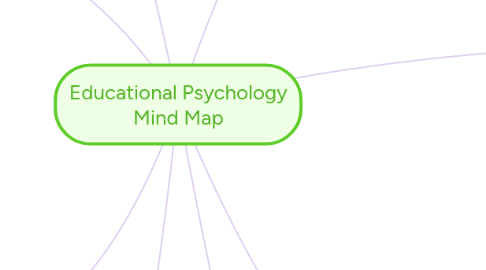
1. Week 1: Planning for the Upcoming School Year
1.1. Schwab's four commonplaces of education
1.1.1. Teacher
1.1.2. Student
1.1.3. Curriculum
1.1.4. Setting
1.2. Constructivism: Students develop their own knowledge
1.3. Authentic activities: Activities allow students to apply what they are learning outside of school
1.4. Top-down approach
1.4.1. Curriculum
1.4.2. Units
1.4.3. Daily Lesson Plans
2. Week 2: Considering Developmental Differences
2.1. Adora Svitak: "Learning between grown-ups and kids should be reciprocal."
2.2. Development
2.2.1. Orderly and logical progression (e.g., people talk before they read)
2.2.2. Does not progress at constant rate
2.2.3. Results from genetic and environmental influences
2.3. Zone of proximal development: Range of tasks child cannot perform alone but can perform with help of others
2.4. Scaffolding: Giving students just enough help to incite learning
2.5. Yerkes-Dodson Law
2.5.1. Tasks too challenging or too easy decrease learning
2.5.2. Goal is to present students with tasks that are challenging but attainable
2.6. Theory of mind: Understanding that others have different thoughts, beliefs, feelings, and perceptions
3. Week 3: Establishing Positive Learning Environment
3.1. Absence of good classroom behaviour is a performance-deficit problem
3.2. Classroom management strategies
3.2.1. Both students and teachers collaboratively establish classroom expectations
3.2.2. Teacher offers support to students
3.2.3. Keep low ratio of punitive to positive interventions
3.2.4. Minimize off-task time
4. Week 4: Making Instructional Decisions
4.1. Backward design: Instruction developed based on specific learning objective
4.1.1. Specific learning objective
4.1.2. Assessment question
4.1.3. Topical unit and lesson plans
4.1.4. Instruction method
4.2. Differentiated instruction: Give different groups of students separate tasks based on same theme, so all of them still learn the content
4.3. Exit tickets
4.3.1. Allow students to express what they have learned
4.3.2. Gives teacher the ability to see any misunderstandings so teacher can address it
5. Reference: Edmunds, A., & Edmunds, G. (2015). Educational psychology: Applications in Canadian classrooms (2nd ed.). Don Mills, ON: Oxford University Press.
6. Week 8: Standardized Achievement Tests
6.1. Preparing a class for the test
6.1.1. Focus on teaching good lessons
6.1.2. Go over good test writing practices
6.1.3. Provide information on test format and procedures
6.2. Arguments for
6.2.1. Keeps schools accountable to taxpayers and parents
6.2.2. Lets parents see how well their child is doing compared to the provincial standard
6.3. Arguments against
6.3.1. Can be very stressful to students and teachers
6.3.2. Forces teachers to adjust their lessons to the test
6.3.3. Test results handed out a lot later than they are administered
7. Week 5: Assessing Student Progress
7.1. Diagnostic assessment: Student knowledge determined before instruction
7.2. Bloom's taxonomy: Cognitive learning objectives
7.2.1. Knowledge
7.2.2. Comprehension
7.2.3. Application
7.2.4. Analysis
7.2.5. Synthesis
7.3. Stiggins's achievement targets
7.3.1. Knowledge
7.3.2. Reasoning
7.3.3. Skills
7.3.4. Products
7.3.5. Attitudes and Dispositions
7.4. Inquiry-based learning
7.4.1. Types of questions
7.4.1.1. Inference questions: Look beyond information readily available
7.4.1.2. Interpretation questions: Understand consequences of information and ideas
7.4.1.3. Transfer questions: Apply what they know to other areas
7.4.1.4. Questions about hypotheses: Questions about what can be predicted and tested
7.5. Universal instructional design: Designed to be accessible and effective for all students
8. Week 6: Individual Differences-Intellectual Abilities and Challenges
8.1. Including students with exceptionalities
8.1.1. Include students in planning programming
8.1.2. Implement a variety of instructional methods
8.2. Special education
8.2.1. Inclusion
8.2.1.1. Students with exceptionalities are educated in regular classroom as a first resort
8.2.2. Individualized Education Program (IEP)
9. Week 7: Socio-Cultural Considerations
9.1. Culturally responsive classroom (Edmunds & Edmunds, 2015, p. 252)
9.1.1. "[L]ink classroom content to students’ cultural experiences" Can help students gain appreciation for other people's background and how it is similar to or different than their own
9.1.2. "[I]mplement culturally relevant instruction methods" E.g., storytelling circles
9.2. Stereotype threat
9.2.1. Impairs performance
9.2.2. Individual need not believe the stereotype, only needs to know it exists
9.2.3. What to do to combat its impact
9.2.3.1. Teachers should emphasize that a student's ability can be improved by attempting to master new content and skills
9.3. Socioeconomic status (SES)
9.3.1. Impairs performance
9.3.2. Impacted by education, occupation, and income
9.3.3. Effect of parenting style
9.3.3.1. Authoritarian: Attempts to stringently control child's behaviour
9.3.3.1.1. Strongest negative impact on achievement
9.3.3.2. Permissive: Accepting of almost all of a child's actions
9.3.3.3. Authoritative: Associated with higher grades
9.3.4. What to do to combat its impact
9.3.4.1. Provide extra help
9.3.4.2. Share how important education is to them
9.3.4.3. Hear how education is important to people with various levels of SES
